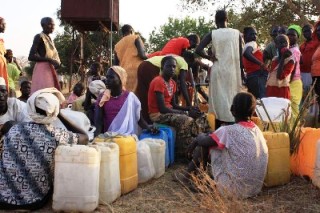UNHCR to improve situation of Sudanese refugees in Ethiopia
By Tesfa-Alem Tekle
February 1, 2013 (ADDIS ABABA) – The United Nations refugee agency (UNHCR) said on Friday that they will be working to stabilise the emergency phase of its response to the Sudanese and Somali refugee influxes in Ethiopia this year.

The program, he said, includes the phasing out of water trucking in favour of more permanent piping systems, and construction of transitional shelters to replace tents.
The UN refugee agency also says it committed to ensuring the timely provision of core relief items to refugees, and is currently building buffer stocks to cope with any new refugee influx.
With regard to refugee issues, UNHCR says emergency preparedness and response mechanisms are its hallmark leadership and coordination role support for host communities around refugee camps is another important element to the agency’s strategy.
Another crucial component of the UN refugee agency is to improve relations between refugee and local communities there to bolster the protection environment, making refugee-hosting areas safer for all, while encouraging both communities to share common services such as education and health facilities.
REFUGEE INFLUX
Since heavy fighting erupted between the Sudanese Armed Forces (SAF) and the Sudan People’s Liberation Movement-North (SPLM-N) in South Kordofan and Blue Nile States in July 2011, tens of thousands of Sudanese refugees have been forced to flee into neighboring Ethiopia and South Sudan.
Most of these fleeing usually arrive at remote areas of Ethiopia’s Benishangul-Gumuz state and in South Sudan’s Unity and Upper Nile states.
Ethiopia witnessed high influx of refugees in April and May last year, with an average rate of 200 to 300 people a day.
However Kisut told Sudan Tribune that the current level of new arrivals from Sudan can be considered as modest, rather than an influx.
“This however does not in any way suggest the end of the displacement situation,” he said adding, “UNHCR and its partners remain seized with making the necessary preparations to be able to effectively respond to any further displacements that may occur”.
At the end of December 2012, Ethiopia hosted over 86,000 refugees from Sudan in the three camps (Sherkole, Tongo & Bambasi) in the Benishangul-Gumuz State as well as in one camp (Pugnido) in the Gambella State.
The figure includes an estimated 20,000 displaced people from South Sudan’s Jonglei State, who are staying with the host communities along the border in Wantawo woreda, Gambella State.
REPATRIATION OPERATION
Currently there is no active repatriation operation to the thousands of Sudanese refugees.
There has been a huge repatriation operation to Sudan between 2006 and 2009, helping over 36,000 refugees who volunteer to return.
The series of repatriation operations resulted in closing of three refugee camps, which used to shelter them.
There has never been an organized repatriation operation afterwards.
REFUGEE FIGURES
Ethiopia has increasingly been very welcoming to refugees crossing to its territory from neighboring African countries.
Every month, Ethiopia generously receives thousands of new refugees’ who flee conflicts at their home country. The country, for instance, currently hosts more than 91,000 Sudanese refugees.
In addition to the Sudanese refugees, the horn of Africa’s nation also shelters more than 214,000 Somali refugees, 61,000 Eritreans and over 4,000 refugees from other African countries.
Last year, Ethiopia received more than 25,000 Somalis – making it the largest recipient of Somali refugees in the region after Kenya.
(ST)
